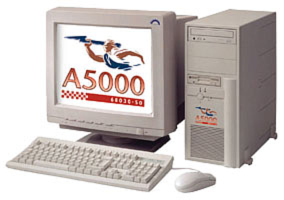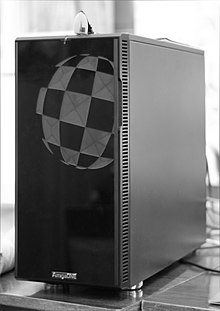
Amiga is a family of personal computers introduced by Commodore in 1985. The original model is one of a number of mid-1980s computers with 16- or 16/32-bit processors, 256 KB or more of RAM, mouse-based GUIs, and significantly improved graphics and audio compared to previous 8-bit systems. These systems include the Atari ST—released earlier the same year—as well as the Macintosh and Acorn Archimedes. Based on the Motorola 68000 microprocessor, the Amiga differs from its contemporaries through the inclusion of custom hardware to accelerate graphics and sound, including sprites and a blitter, and a pre-emptive multitasking operating system called AmigaOS.

PowerPC is a reduced instruction set computer (RISC) instruction set architecture (ISA) created by the 1991 Apple–IBM–Motorola alliance, known as AIM. PowerPC, as an evolving instruction set, has been named Power ISA since 2006, while the old name lives on as a trademark for some implementations of Power Architecture–based processors.

The Amiga 600, also known as the A600, is a home computer introduced in March 1992. It is the final Amiga model based on the Motorola 68000 and the 1990 Amiga Enhanced Chip Set. A redesign of the Amiga 500 Plus, it adds the option of an internal hard disk drive and a PCMCIA port. Lacking a numeric keypad, the A600 is only slightly larger than an IBM PC keyboard, weighing approximately 6 pounds (2.72kg). It shipped with AmigaOS 2.0, which was considered more user-friendly than earlier versions of the operating system.

In computing, an expansion card is a printed circuit board that can be inserted into an electrical connector, or expansion slot on a computer's motherboard to add functionality to a computer system. Sometimes the design of the computer's case and motherboard involves placing most of these slots onto a separate, removable card. Typically such cards are referred to as a riser card in part because they project upward from the board and allow expansion cards to be placed above and parallel to the motherboard.

The Amiga 2000, or A2000, is a personal computer released by Commodore in March 1987. It was introduced as a "big box" expandable variant of the Amiga 1000 but quickly redesigned to share most of its electronic components with the contemporary Amiga 500 for cost reduction. Expansion capabilities include two 3.5" drive bays and one 5.25" bay that could be used by a 5.25" floppy drive, a hard drive, or CD-ROM once they became available.
AmigaOne is a series of computers intended to run AmigaOS 4 developed by Hyperion Entertainment, as a successor to the Amiga series by Commodore International. Earlier models were produced by Eyetech, and were based on the Teron series of PowerPC POP mainboards. In September 2009, Hyperion Entertainment secured an exclusive licence for the AmigaOne name and subsequently new AmigaOne computers were released by A-Eon Technology and Acube Systems.

In a computer system, a chipset is a set of electronic components on one or more integrated circuits that manages the data flow between the processor, memory and peripherals. The chipset is usually found on the motherboard of computers. Chipsets are usually designed to work with a specific family of microprocessors. Because it controls communications between the processor and external devices, the chipset plays a crucial role in determining system performance.

A graphics processing unit (GPU) is a specialized electronic circuit initially designed to accelerate computer graphics and image processing. After their initial design, GPUs were found to be useful for non-graphic calculations involving embarrassingly parallel problems due to their parallel structure. Other non-graphical uses include the training of neural networks and cryptocurrency mining.

Pegasos is a MicroATX motherboard powered by a PowerPC 750CXe or PowerPC 7447 microprocessor, featuring three PCI slots, one AGP slot, two Ethernet ports, USB, DDR, AC'97 sound, and FireWire. Like the PowerPC Macintosh counterparts, it boots via Open Firmware.
This is a list of models and clones of Amiga computers.
The Amiga is a family of home computers that were designed and sold by the Amiga Corporation from 1985 to 1994.
AmigaOS is the proprietary native operating system of the Amiga personal computer. Since its introduction with the launch of the Amiga 1000 in 1985, there have been four major versions and several minor revisions of the operating system.

AmigaOS 4 is a line of Amiga operating systems which runs on PowerPC microprocessors. It is mainly based on AmigaOS 3.1 source code developed by Commodore, and partially on version 3.9 developed by Haage & Partner. "The Final Update" was released on 24 December 2006 after five years of development by the Belgian company Hyperion Entertainment under license from Amiga, Inc. for AmigaOne registered users.
P. A. Semi was an American fabless semiconductor company founded in Santa Clara, California in 2003 by Daniel W. Dobberpuhl, who was previously the lead designer for the DEC Alpha 21064 and StrongARM processors. The company employed a 150-person engineering team which included people who had previously worked on processors like Itanium, Opteron and UltraSPARC. Apple Inc acquired P.A. Semi for $278 million in April 2008.

Sam440, also known by Sam or its codename Samantha, is a line of modular motherboards produced by the Italian company ACube Systems Srl. The Sam440ep version is a motherboard based on the PowerPC 440EP system-on-a-chip processor which includes a double-precision FPU. It is made by AMCC. Their primary targets are the industrial and embedded markets, running operating systems such as Linux and AmigaOS 4.

The Power A5000 was a planned Amiga clone computer, announced by German DCE Computer Service GmbH and British Amiga peripherals manufacturer Power Computing Ltd.. It was one of the first Amiga clone computers announced after Gateway purchased the Amiga in 1997.
The following history of the AmigaOS 4 dispute documents the legal battle mainly between the companies Amiga, Inc. and Hyperion Entertainment over the operating system AmigaOS 4. On 30 September 2009, Hyperion and Amiga, Inc. reached a settlement agreement where Hyperion was granted an exclusive, perpetual and worldwide right to distribute and use 'The Software', a term used during the dispute and subsequent settlement to refer to source code from AmigaOS 3 and earlier, and ownership of AmigaOS 4.x and beyond.

Sam460ex is a line of modular motherboards produced by the Italian company ACube Systems Srl. The machine was released in October 2010 and can run AmigaOS 4, MorphOS, or Debian GNU/Linux.
Warp3D was a project founded by Haage & Partner in 1998 that aimed to provide a standard API that would enable programmers to access, and therefore use, 3D hardware on the Amiga.

A new version of AmigaOS was released on December 24, 2006 after five years of development by Hyperion Entertainment (Belgium) under license from Amiga, Inc. for AmigaOne registered users.















